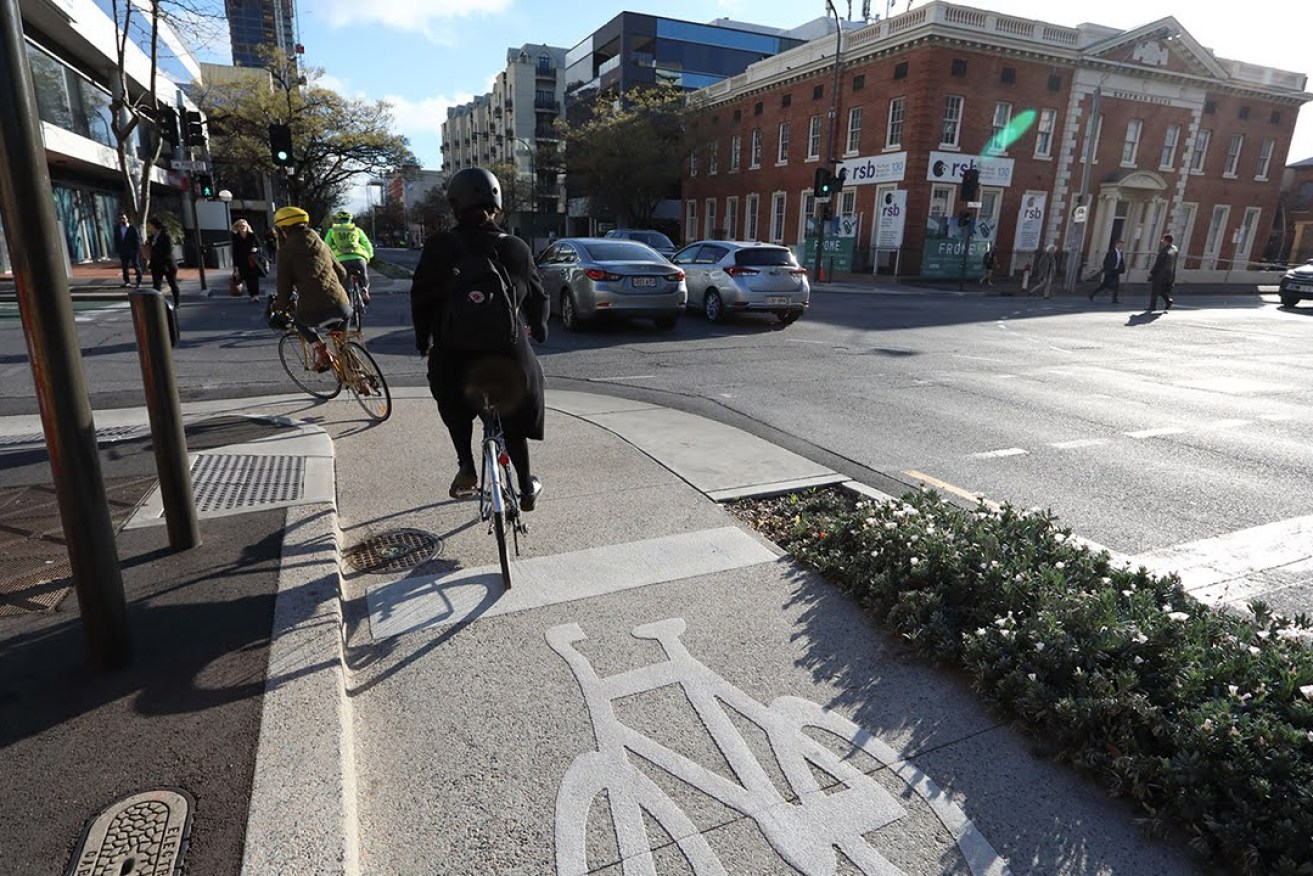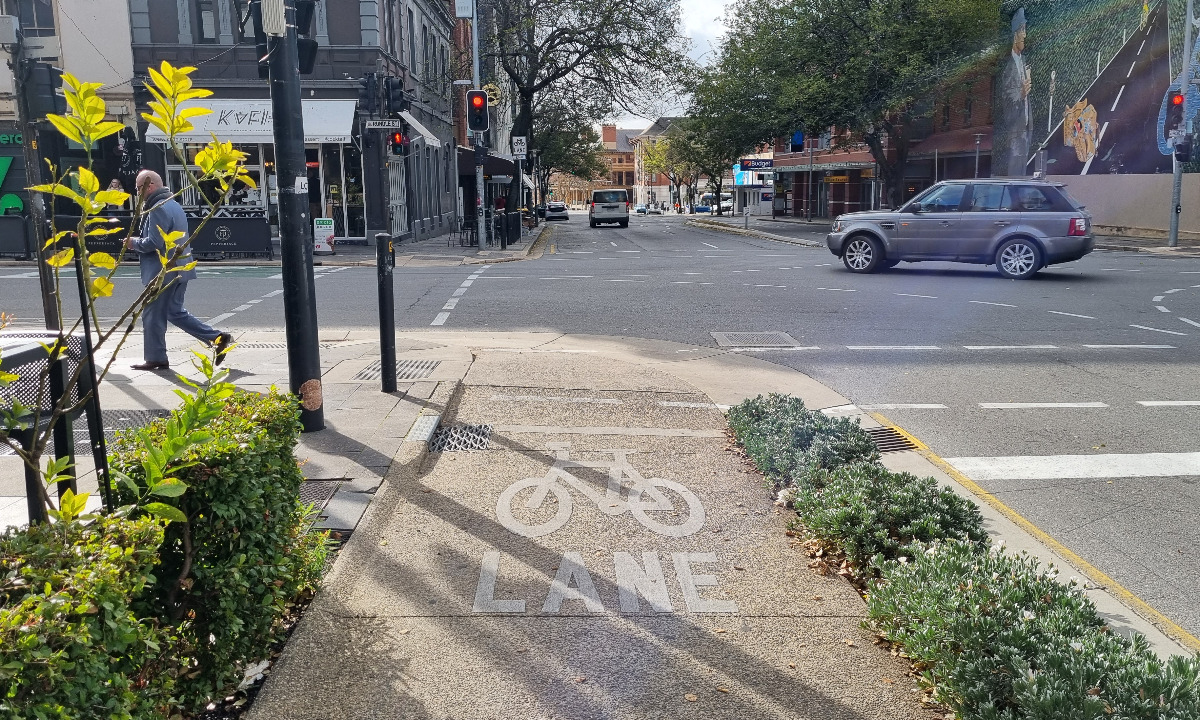Micro solutions to Adelaide’s commute
Instead of hating on e-scooters and other forms of micro-mobility, Adelaide should embrace them as an opportunity to transform our streets.


It has been nearly 10 years since the first stage of the Frome Street bikeway was opened and it still isn't completed. Photo: Tony Lewis/InDaily
Nearly a decade ago, the Weatherill Government caused a few political observers to spit out their tea when the then Governor opened the new Parliament.
Or, at least, look up quizzically for a few moments.
It was early 2015, and the then Premier hit the re-set button on Parliament – a formality that allowed some pomp and circumstance, including the Governor attending the chamber to run through the government’s agenda.
Among the very Jay-like list of aspirations was one that came out of the blue – the idea of legislating to allow trials of driverless vehicles on South Australian roads.
The argument was that the state’s archaic road rules had to be updated to take into account this astounding new technology, with the Government convinced that more-or-less autonomous vehicles would be ready for market in quick time, easing congestion, giving freedom to the house-bound, and all but eliminating vehicle accidents.
We now know that this Utopian future has not yet eventuated, apart from some trials in controlled environments.
While driver-assist technology has continued apace, the fully autonomous vehicle is far from a fixture on the open road. There have been some well-documented disasters involving failed tech, and critics say car companies have overreached – consistently underestimating the complexity of recreating human driving judgement and skill.
With the benefit of hindsight, the Government would have been better off turning its attention to a less glamorous, but potentially game-changing technology – micro-electric transport.
Since Governor Hieu Van Le gave that speech, the market for electric bikes and scooters has exploded in Australia, including in South Australia where you can “rent” an e-scooter but it remains illegal to ride a privately-owned electric scooter in public places. That looks likely to be fixed by state legislation this year, moving e-scooters from their purgatory in endless council-supported “trials”, to a legitimate form of transport.
Likewise, e-bikes are now a huge market in Australia. By some industry estimates, e-bike imports from 2017-18 to 2021-22 grew on average by 45.9 per cent – a massive figure for any market, and possibly an underrepresentation of the true size of the e-bike explosion.
Anecdotally, South Australia’s streets are filled with e-bikes – for deliveries, commuting or having fun.
E-bikes are regulated, but these rules are clearly not enforced uniformly.
In SA, neither of the two classifications of “power-assisted” bicycles are allowed to be propelled only by the motor, but you only need to look out the window of a city office to see e-bikes scooting along under throttle.
You can understand authorities wanting to draw a distinction between unregistered bicycles and what are effectively lightweight motorcycles or scooter-type vehicles, but again regulators risk falling behind rapid changes in e-technology.
Power restrictions – either 200kw or 250kw depending on the class of e-bike – are arguably out of sync with potential uses, such as use of heavier-duty cargo bikes to make deliveries.
In 2021, the NSW Productivity Commission found that changing regulations to support the use of “personal mobility devices” such as e-scooters could “unlock up to $87 million in net economic benefits in today’s dollars by 2041”.
It estimated that the right framework could enable between eight and 10 million trips per year, with the greatest benefit being travel time savings, followed by savings in vehicle operating costs.
Tellingly, it found that these benefits outweighed negative impacts on active transport, safety and enforcement.

Frome Street’s protected bikeway simply ends, 10 years after its first section was opened. Photo: Thomas Kelsall/InDaily
Micro-mobility devices are quiet, efficient and sustainable and, while they can be expensive, they are still significantly cheaper than owning a car.
In Adelaide, with our flat topography and wide streets, we have a huge opportunity to take cars off our increasingly congested road network.
The problem is a lack of planning.
As others have pointed out, electric scooters and e-bikes are perfect for short trips in crowded cities, both for commuters and deliveries – but the problem is where to put them for the safety and ease of everyone.
They’re faster than pedestrians, so can be a worry on footpaths, and slower and more vulnerable than motor vehicles, so they aren’t always a comfortable ride on crowded city roads.
The logical place for them is the bicycle network – something we don’t have much of in Adelaide. This is an area of huge underinvestment in South Australia. There is little State Government investment in the pipeline and many local councils have proven to be hopeless in this realm.
The first stage of the CBD’s only protected bikeway – on Frome Street – opened nearly 10 years and three Lord Mayors ago and it still hasn’t been completed. The long-promised complementary east-west bikeway hasn’t been built.
Studies overseas show that e-scooter riders prefer using cycle paths but will use footpaths when cycling infrastructure is inadequate. It makes sense to at least begin with a comprehensive inner-city network and look at integrating paths with transport hubs in the outer metropolitan areas.
Integrating micro-mobility with public transport could be a game-changer for South Australia, fixing the so-called “first and last mile” problem and saving the taxpayer money.
Up in the Adelaide Hills, for example, the State Government is putting on hundreds more bus services between towns and to the city – but there’s no accompanying expansion of park-and-ride or feeder services to deliver people to the key bus stations. Micro-mobility could breach this gap, with investment in bicycle paths and either storage at transport hubs or on-board buses, something that is common elsewhere.
Imagine if eight years ago, the Weatherill Government had turned its attention and political weight – in terms of regulation and investment – to at least beginning to address our cycling infrastructure.
The idea might not have turned as many heads as its driverless vehicle gambit, but Adelaide could be a quite different place to live and work today.
Notes on Adelaide is a weekly column reflecting on the city, its strengths and its foibles. You can read more Notes on Adelaide in SALIFE’s print editions.




